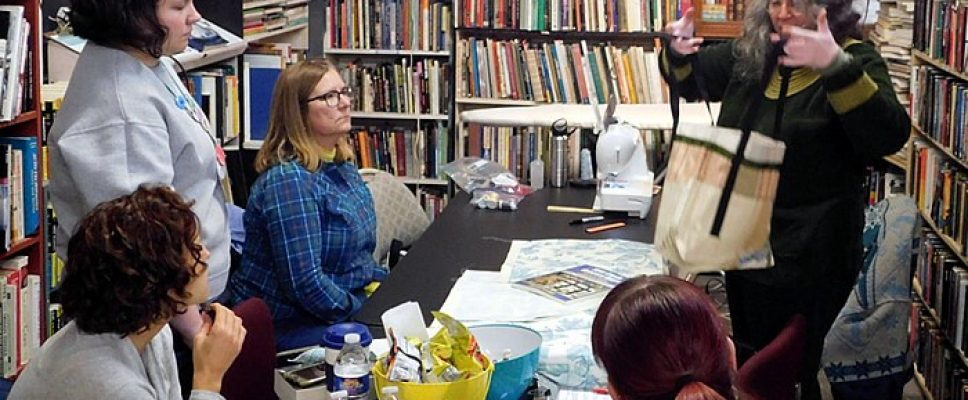Bookstore Holds How to Sew Cloth Grocery Bags Class
I spent several years working on the manuscript for “Sew Cloth Grocery Bags: Make Your Own in Quantity for Yourself, for Gifts, or for Sale.” The book gradually got bigger and more complete, particularly when Bill asked “Is there only one way to sew a cloth grocery bag?” As it turns out, there are two methods but teaching myself the second one (boxed) added a couple years to the writing time. Almost done!
Then we sent out the manuscript to my beta-sewers.
Everyone was able to follow my directions for the tailored bag style. This style is intuitive; if you know what a cube looks like, you can see how to sew the three sections together: front panel, back panel, and a gusset connecting the two. It is three-dimensional from the very first step.
The boxed-bag style, however, was confusing. It takes a single rectangle of cloth and transforms it into a three-dimensional box using origami with an iron. My beta-sewers agreed. This style needed better explanations, better diagrams, better photos, and yes, a demonstration would be helpful too.
I put a lot of emphasis on the boxed bag style in the book because if you are making dozens of bags, the boxed bag is more efficient in every way. It’s faster to lay out, faster to cut, faster to sew. It also has virtually zero waste compared to the tailored style so the fabric cost is lower.
But the boxed bag’s construction is not intuitive.
Back to the drawing board. I cleaned up my directions, we took more pictures, we clarified images, and added new diagrams showing the process better.
We published the book! Happy day.
It still bothered me that this is a construction method that benefits from being seen. I certainly spent hours and hours figuring out how to press those triangular wings, sewing them, and then sewing them in place, forcing a two-dimensional sack into a three-dimensional cube. I can press and sew triangular wings lickety-split these days, but I’ve had lots of practice.

Teaching Sewing Class
 Then the idea struck. Why not do demonstrations? A demonstration really is worth thousands of words and dozens of pictures, so that’s what we did. Cupboard Maker Books hosts a monthly Fun Yarns Book Club that combines books and crafts.
Then the idea struck. Why not do demonstrations? A demonstration really is worth thousands of words and dozens of pictures, so that’s what we did. Cupboard Maker Books hosts a monthly Fun Yarns Book Club that combines books and crafts.
Michelle was kind enough to let me take over on Tuesday, 12 November 2019 to give demonstrations. We (Bill provided the manual labor) hauled out my Baby Lock sewing machine, iron, ironing board, trouble lights, big bag of sewing notions, trim, precut bag straps, and a stack of panels, some of which I pre-sewed.
I didn’t know exactly what I would do since I’ve never demonstrated how to sew a boxed bag for an audience of eager crafters. I brought panels that needed to be sewn, since then I could show the entire process and I brought partially sewn panels, to demonstrate only the triangular wing section over and over.
I did make sure that my panels were all fabric with a definite right and a wrong side. There’s a lot of turning inside-out and back again in the construction process and having a definite “wrong” side makes it easier to see which step you are on.
The evening went well. We got set up in plenty of time. Despite putting both the high-draw iron, sewing machine, and trouble lights on one circuit, we didn’t blow any fuses at Cupboard Maker.
And I sewed bags. As it turned out, what the guests wanted to see was the process from start to finish. I demonstrated several parts of the process, leaving me with partially sewn panels for use later on. And I sewed one complete bag from start to finish, with talking time, in about an hour. Maybe less.
That’s how fast boxed bags are.
Remember, it’s not all sewing machine time either. I have to iron the bag at various stages and not just the triangular wing. I’ve also got to mark the trim-line placement and mark and pin the straps. That is time spent getting up and down and fiddling with the bag, making it behave.
Everyone there got to see how to sew a cloth grocery bag and I believe they left understanding that 1) it’s not hard and 2) it’s fast. The sewing is straightforward (all straight lines!) and there’s no fitting, gathering, darting, buttonholes, inserting zippers, or any of the other myriad techniques that make sewing a fitted suit such a challenge.
A cloth grocery bag is a specialized sack and anyone who can sew can make them by the dozen.
Thank you to Michelle, Sam, and Cupboard Maker Books for hosting me and all my gear. If the stars align and interest appears, I’ll be back to demonstrate how to sew cloth grocery bags again.
